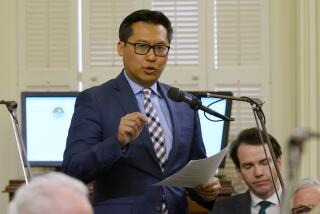Study upends term-limit theory
The vision of legislative term limit advocates — that of “citizen legislators” dominating California’s Capitol — always was a fantasy. Now a think tank proves it.
The research group has splattered indelible facts all over the Norman Rockwell image of a selfless local merchant serving a few years in Sacramento, then returning home to tend the store and resume community volunteerism.
“The record disputes the idea that legislators will return to their pharmacy, return to their farm, return to their law firm,” says Bob Stern, president of the Center for Governmental Studies.
“Once they get into government, they find they are good at it, and they like it.”
Well, not all are good at it — at least not the governing. But they do tend to like the perks and the power.
The center Tuesday produced a report titled “Citizen Legislators or Political Musical Chairs?”
The report concludes unequivocally that the answer is musical chairs.
“California’s term limits have not created an environment in which citizen legislators temporarily serve in the state Capitol and then return to the private sector,” the reports says. Rather, “professional legislators…continue to seek careers in other government positions — a form of political musical chairs for governmental office.”
“Indeed,” the report continues, “politicians are now moving faster and faster to the music.”
And, mixing metaphors, it adds, “Most termed-out legislators do not beat their political spears into plowshares and return to the civilian sector....Term limits…have converted the state Legislature into a ‘farm team’ of potential candidates for other public offices.”
The governmental studies center compared legislators before and after term limits. It found:
•”A growing portion of newcomers to the Legislature are not citizen legislators at all, but rather politicians who have served in local government.”
In 1990 — as voters were approving term limits — 28% of those elected to the Assembly came from local government. By 2010, the number had risen to 68%. For the Senate, the number rose during that period from 35% to 70%.
•”Termed-out members are just as likely to seek other public-sector jobs as were pre-term limits predecessors.”
In the 1980s, 60% of Assembly members and 30% of senators, upon leaving the Legislature, either ran for another office or landed some government appointment. In 2008, 60% of termed-out Assembly members and 40% of vanquished senators hung onto government employment.
Under California’s term limits — among the most restrictive in the nation — three two-year terms are allowed in the Assembly and two four-year stints are permitted in the Senate.
Anyone who has watched the legislative process in Sacramento has witnessed the obvious: Newly elected lawmakers start plotting to capture their next office even before they’re sworn in to the one they’ve just won.
“They’re running all the time, for one office or another,” complains Maria Elena Durazo, executive secretary-treasurer of the Los Angeles County Federation of Labor.
She gets tired of term-limited politicians showing up with their hands out. “We raise money over and over again, one after another after another....
“I really believe most are good, decent people, but they’re caught up in a system that forces them to move quickly.
“Both labor and business get tired of, over and over, trying to teach them about our issues, and in the end the only thing that determines how they’re going to vote is a calculation of what’s going to happen in the next election.”
For legislators facing term limits, there seems to be little sense of being in it for the long haul and having a stake in California’s future. If they’re creating a big mess, the job of cleaning it up will fall to their successors.
And, oh yes, there also are these problems, the study points out: Compared to legislators before term limits, lawmakers today are less experienced at legislating, less knowledgeable about public policy, weaker in dealing with the governor and more dependent on their staffs and lobbyists.
“The musical chairs taking place is not beneficial to anyone,” says Gary L. Toebben, president of the Los Angeles Area Chamber of Commerce. “We need some experience and stability in Sacramento.”
The business community suffers, Toebben says, because of “a lack of action, a lack of compromise.” Legislators won’t compromise, he continues, “because they’re going to be running for another office relatively soon, and they don’t want to make their major supporters unhappy. They won’t make the tough decisions necessary in a democracy.”
Most recent example: The failure of Democrats and Republicans to compromise on a plan to place a tax measure on the ballot in exchange for spending, pension and regulatory reforms. “A lost opportunity,” Toebben laments.
The L.A. chamber and the L.A. labor federation — an unlikely coalition — are sponsoring a term-limits reform initiative that will be on the next statewide ballot, probably in June 2012.
The measure would allow legislators to serve only 12 years total, compared with 14 now. But all the time could be spent in one house. Legislators could serve longer on committees and in leadership roles, becoming more knowledgeable and effective. No current lawmakers would be affected.
The think tank endorses the idea.
A strong supporter is Jim Brulte, former Republican leader in both legislative houses. He favors term limits, but thinks California’s system is broken and the proposed change would be a good fix.
“Special interests have significantly more influence today than before term limits,” he says. Legislators “don’t have the ability or willingness to stand up and tell their core constituencies ‘No.’”
The term-limits pipe dream has become a nightmare. Time to wake up.
More to Read
Start your day right
Sign up for Essential California for news, features and recommendations from the L.A. Times and beyond in your inbox six days a week.
You may occasionally receive promotional content from the Los Angeles Times.







